Not bound by departmental divisions, the new Computational Science and Engineering building allows researchers and students from a variety of disciplines to find inspiration at the intersections of their fields.
If you walk, any night of the week, onto the Homewood campus through its southern gate, you’ll see one building glowing amid an otherwise darkened campus. Light radiates from within, pouring out through the white-paned windows, illuminating the surrounding brick and marble trimmed sidewalks. As the nearby buildings slumber, the new Computational Science and Engineering (CSE) building pulses through the night, charged with an energy seemingly more vibrant than mere electricity…
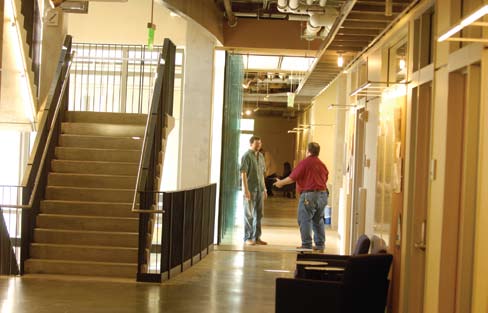
Monday morning brings quite a different scene as faculty, staff, and graduate students stream into offices and laboratories throughout the CSE building’s four floors, which are connected inside by an elevator and a floating staircase. Each floor has a wide central corridor, and the individual labs, offices, and conference rooms that sit like vertebra along this backbone are home to various engineering research groups.
At the ground level, the mammoth robotics equipment of the Laboratory for Computational Sensing and Robotics (LCSR) towers above lab benches in the building’s twostory, open-air laboratory high bay. One floor above, in the Swirnow Mock Operating Room, researchers from the Center for Computer- Integrated Surgical Systems and Technology (CISST) develop and test robotic surgical techniques. On the second floor, the Institute for Computational Medicine’s (ICM) server room can be seen through its glass walls, blue and purple lights gleaming, its cooling mechanism creating a soft hum. And the third floor is home to the labs and offices of the Center for Language and Speech Processing (CLSP).
Unlike its neighboring buildings, the CSE building is not dedicated to a particular department, but to four of the Whiting School’s interdisciplinary institutes and centers.
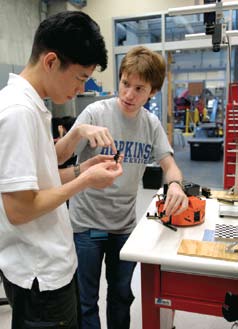
Jusuk Lee, a fifth-year PhD student in the LCSR , uses computational methods to learn how cockroaches run and how humans walk and run. Today he is at work on his computer in the Locomotion In Mechanical & Biological Systems (LIMBS) lab run by his advisor, assistant professor Noah Cowan. His task: to create computer simulations of locomotion. Lee divides his time between building robots that replicate the gait of the cockroach and creating computer simulations that replicate the gait of the human.
“To understand why humans inherently strive for a symmetric gait we make mathematical models that represent human running motion and simulate the models with a computer,” Lee explains. “The power of mathematics is that it provides proof to support or refute a theory. Using these mathematical models, we can help biologists narrow down the variables they consider.”
The end goal? To learn how animals turn sensory information into action so that physicians can diagnose people with abnormal gaits caused by neurological damage and create rehabilitation plans for them.
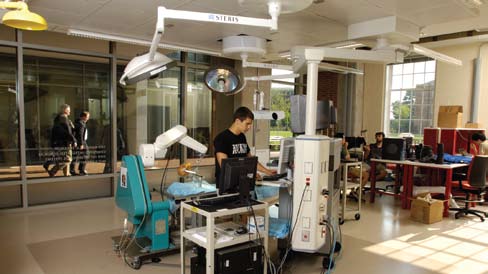
And why cockroaches? Interestingly, the gait of humans and that of cockroaches are similar: both bounce from step to step as they run. But the real allure of cockroaches lies in their ability to run extraordinarily fast (equivalent to humans running at 200 mph) under guidance from their antennae. Understanding animal locomotion at the limits of performance can lead to new insights into biology and evolution, and also to the development of novel robotic sensors and algorithms.
Lee alternates between the office and the lab, or “labpod,” in which he and fellow graduate students build the robots they use to test their theories. In contrast to his orderly office, Lee’s labpod, one of many that line the perimeter of the high bay, is filled with machinery, tools, and robotics equipment. Workbenches are covered with a jumble of hammers, pliers, screwdrivers, soldering irons, flat screen monitors, keyboards, towering hard drives, and spools of wire. A large, red toolbox stands by the door, its drawers labeled, “screwdrivers, sockets, clamps, sand paper, hammers, nails and screws,” and “squeezy things.”
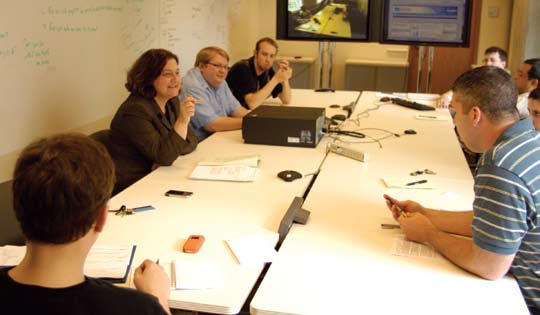
Later in the day, Lee sits among this mélange discussing the latest enhancements that Alican Demir, a mechanical engineering master’s candidate in the LIMBS lab, has made to the cockroach robot.
About a cubic foot in total size, the robot has three wheels, a chassis, a controller base, and a single antenna that sweeps out from its side. As it speeds along a wall, it can measure its distance from the wall by constantly calculating the shape of its antenna. Inside, a wireless modem instantly sends the data to a nearby computer. “When you’re going to build a robot,” Demir says, “your goal is to build something that can do things humans can’t. Like communicate wirelessly and directly to a computer.”
Several floors above this duo, Anne Albinak is at work in her office, preparing for the next morning’s Institute for Computational Medicine staff meeting. Albinak, the administrative director of the ICM, oversees the staff of nine software engineers, systems administrators, and administrative staff who are building the Cardiovascular Research Grid (CVRG). The grid, which is just one of the ICM’s many projects, will be the first worldwide digital data network dedicated to the open exchange of information on heart-related illness.
Unlike its neighboring buildings, the CSE building is not dedicated to a particular department, but to four of the Whiting School’s interdisciplinary institutes and centers.
Three years ago, when Albinak was recruited to become administrative director of the ICM, it wasn’t just her background in administrative management that was appealing. It was also her passion. “I don’t know the science or the math,” she says. “But, everything I do can make a direct impact on the research, and that’s what keeps me motivated.”
Funded in large part by the National Heart, Lung, and Blood Institute at the National Institutes of Health, the completed Cardiovascular Research Grid will enable research teams from all over the world to access and share experimental data, data analysis tools, and computational models.
As the lead collaborator for the project, the ICM at Hopkins partners with colleagues at Ohio State University School of Medicine and the University of California, San Diego. To keep all the parties in this long-distance relationship well connected, the group’s second floor conference room is equipped with two flat screen monitors that stand side by side at one end of the conference table. The monitors are digitally linked to conference rooms at the collaborating universities so that, when need be, all three parties can easily communicate.
At Tuesday morning’s staff meeting, Albinak listens carefully as each of the eight staff members gives the status of their current project. When it becomes clear that one of the partnering collaborators has caused a delay on a small but significant aspect of the project, Albinak’s response is gentle but firm. “We’re the lead institution, so it’s our responsibility to push the ones who are lagging behind,” she reminds the team.
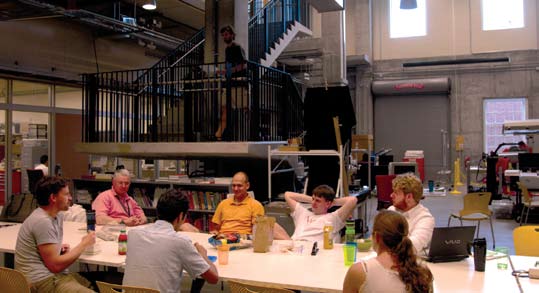
With funding for four years, the project is about halfway into its second year and the ICM has, so far, created multiple storage methods that can accept various forms of clinically derived data such as ECG, genome, and protein. Today the team is discussing how to integrate all that data and enhance the methods by which the end-user can access and analyze it.
An ample view of the grassy engineering quad and the facade of Shriver Hall can be spied from the conference room’s long window, but the team is instead focused on what’s written in orange marker on the whiteboard wall. “WebSSO, XML Data Service, AIM/XNAT, HL7aECG, WFDB, Open Clinica, Protein DB.” This cryptic list of acronyms inspires an animated discussion of how to create website flow so that individuals can both access it and add their own information.

Eventually, the ICM team’s efforts will manifest in a bevy of grid-based software tools that will enable researchers to access and confidentially share information comparing the tissue of healthy people with those who have cardiac disease—and thus accelerate the treatment of heart disease.
Down the hall, on the northern end of the third floor, faculty members Sanjeev Khudanpur and Jason Eisner are conferring outside the offices of the Center for Language and Speech Processing. Khudanpur is an associate professor in the Department of Electrical and Computer Engineering, while Eisner is an associate professor in the Department of Computer Science. The two collaborators used to work in separate buildings. Now their offices are just a few steps away from each other.
“Jason is the algorithm guy and I’m the model guy,” is how Khudanpur explains their relationship. “One thing that this building has done,” he continues, “is enhance our ability to work together. We used to be scattered in so many places. We had a strong bond at an intellectual level, but now everyone is literally next door. It makes it so much easier to talk to people.”
And that’s exactly what they do each Wednesday at 1:30 p.m., gathering in a meeting room they’ve dubbed “the fishbowl.” With two walls made entirely of glass, the room provides those inside with adjacent views of the floating staircase and central hall— and those passing by a glimpse of the work taking place within. Here in the fishbowl the engineers are joined by linguists from the Department of Cognitive Science in the School of Arts and Sciences to swap ideas on the many ways in which people process language. The linguists study how the brain learns and uses language, and they want to learn computational models from the engineers to explain the workings of this human ability. The engineers build computers to learn and use language, and want to gain greater insights into how humans do this.
“We would like to get a computer to understand speech and text with as much nuance and depth as a human would,” Eisner explains. By achieving that, computers could help manage the vast quantities of information available and, even, automate some of what we do, he says. “Computers have taken over a lot of the drudgework that used to fall to secretaries, librarians, accountants, and clerks. We want this trend to continue,” Eisner notes. “Perhaps they’ll understand your email well enough to draft responses for you, manage your calendar, follow up with others, and remind you of your own promises.” What’s more, he says, since more and more human activity is going online, “the Web is our Library of Alexandria. Wouldn’t it be a pity for all that information to sit out there and have nothing done with it?”
“We used to be scattered in so many places. We had a strong bond at an intellectual level, but now everyone is literally next door. It makes it so much easier to talk to people.” Sanjeev Khudanpur
Yet, there are hurdles to creating machines that can sift, understand, and organize those enormous tomes of verbal and written information (not just websites, but also books, research papers, news articles, newscasts, fiction, blogs, reviews, etc.). As Khudanpur points out, “Speech can be ambiguous due to dialects, pronunciations, surrounding noise, mispronunciations. When humans hear it, they can sort it out by analyzing the context. Computers can’t, because they lack the real understanding of language that is needed to resolve such uncertainty.”
In his office, Khudanpur keeps an old-fashioned cassette tape player. By rapidly alternating between play and pause, he demonstrates how single words, when heard individually, can be surprisingly difficult to understand. Yet, when heard within a complete sentence, the word being uttered is suddenly obvious.
Consequently, the researchers in the CLSP spend their days and nights mapping out clues for the computer to look for that address the multitude of language uncertainties. “We build a degree of freedom into the model by giving the computer a range of possibilities and allowing it to adjust within them,” Khudanpur says. “Essentially, we’re giving the computer a knob that it can adjust to individual speakers.” With such a tuning “knob” the computer can now, for example, figure out that the sounds “pehn,” “peyan,” and “peen” can all mean pen, “particularly if they are preceded by words such as ‘You can write with a…’ Khudanpur explains.
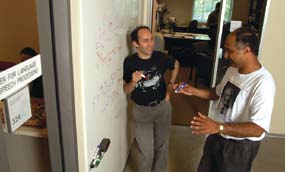
On Thursdays, the faculty, graduate students, and undergraduates affiliated with the CLSP attend a lunchtime paper club in a third floor conference room. Today the room is packed with students and professors. The club, initiated by Eisner, offers a chance for students to sharpen their presentation skills, discuss the latest journal articles, and relax with their colleagues.
“Because these meeting spaces are right here, so close to our offices,” Khudanpur says, “there’s almost no excuse to miss meetings and lectures. In the past, I’d have to walk across campus but now I see people walking past my door to a seminar and think, ‘I should go to that.’ And I do. It’s great to have everyone on this floor, finally working together.”
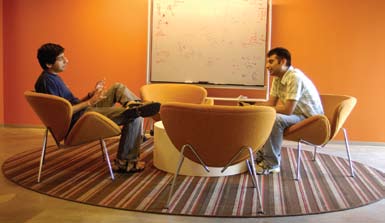
While the luncheon paper club gets under way, Albinak is down the hall, finishing up a weekly meeting with the ICM’s director, Rai Winslow. Once a week they exchange updates on the institute’s operations. Today, they review everything from the status of funding proposals and the benefits of co-applying for grants to the possibility of hiring an additional software designer and the purchase of new office furniture.
Like most faculty and staff offices in the CSE building, Winslow’s is spacious and airy, with a slender, floor-to-ceiling plate glass window next to the door. On his desk are three flat-screen monitors, a Macbook Air, and a single stack of books, meticulously aligned. With a PhD in biomedical engineering from the School of Medicine and an appointment in the Department of Biomedical Engineering, Winslow also has joint appointments in the Engineering School’s Department of Electrical and Computer Engineering and the medical school’s Department of Medicine and its Division of Health Sciences Informatics.
Long before the ICM was a functioning institute, it was an idea formulating in Winslow’s mind and, when he launched it in 2005, Albinak was his first hire. Since then, they’ve worked to build the ICM team to more than 50 people.
While their meeting wraps up, Lee is back downstairs, talking with his own director, Noah Cowan, who launched the LIMBS lab within the LCSR five years ago. Lee updates Cowan on his latest work with research partner Amy Bastian, an associate professor of neurology at the School of Medicine.
Lee and his collaborators meet twice a month to compare the empirical data Bastian gathers while working with patients at the Kennedy Krieger Institute and Lee’s theoretical evidence gained through mathematical modeling of human gait. Through this partnership, Bastian and her team can give examples of how patients adapt to having abnormal gaits. And, in return, “with the models we’ve built,” Lee says, “we are working to give them explanations as to why.”

By the time Friday arrives it is a gorgeous spring day and the atmosphere throughout the CSE building has become decidedly more relaxed. Lee is back in his office, preparing an email to fellow members of the Mechanical Engineering Graduate Association (MEGA). He’s asking for their input in selecting furniture for the newly renovated mechanical engineering student lounge in neighboring Latrobe Hall. Launched in the fall of 2006, MEGA aims to foster interactions among faculty and graduate students through monthly lab socials, prospective graduate student recruiting events, and even the occasional trip to a Baltimore Orioles baseball game.
As Lee finishes up his email, Eisner and Khudanpur return to the third floor conference room for a regularly scheduled noon seminar. Each Friday, lunchtime in the CLSP is devoted to giving graduate students the chance to present their own research to the entire cast of the CLSP. “We try to make this a special event,” Khudanpur explains. “We have only one rule: no pizza.” On this particular Friday, the specialty cuisine is Indian food.
As approximately 40 or so people pack into the room, a few must balance plates and drinks while standing in the doorway. Sitting among the gathering is the CLSP’s director, Fred Jelinek, the Julian Sinclair Smith Professor in the Department of Electrical and Computer Engineering who launched the center 15 years ago. Nikesh Garera, a graduate student in Computer Science, presents “Translating Compound Words Using Cross Language Evidence from Multiple Languages.” Garera’s intensely technical presentation draws a barrage of questions and eventually evolves into a lively discussion.
On the opposite side of the building, the offices of the ICM are dark and silent. Albinak, along with Winslow and the rest of the ICM staff, have gathered on the grassy lawn outside the building’s southern end. Having kicked off her shoes, Albinak relaxes with a Diet Coke. A grill, which the team handily stores in its office kitchenette, sizzles with hamburgers and turkey burgers. A Frisbee is tossed back and forth under a sunny sky.
As the staff and students enjoy a rare Friday afternoon respite from their intense work, the CSE building, its gray slate roof rising four stories above, provides ample shade from the sun. Another workweek in the life of the CSE building comes to a close.




